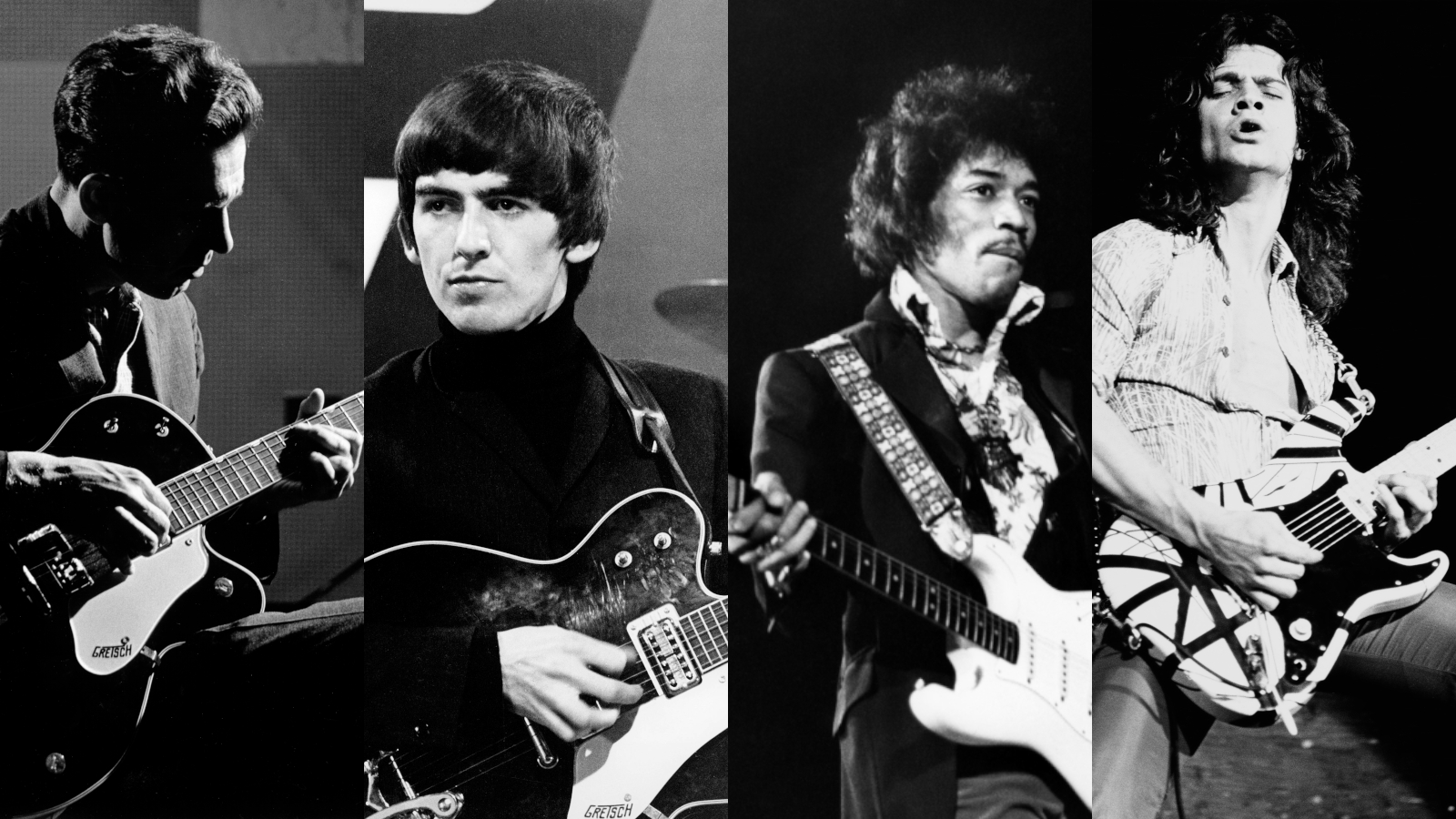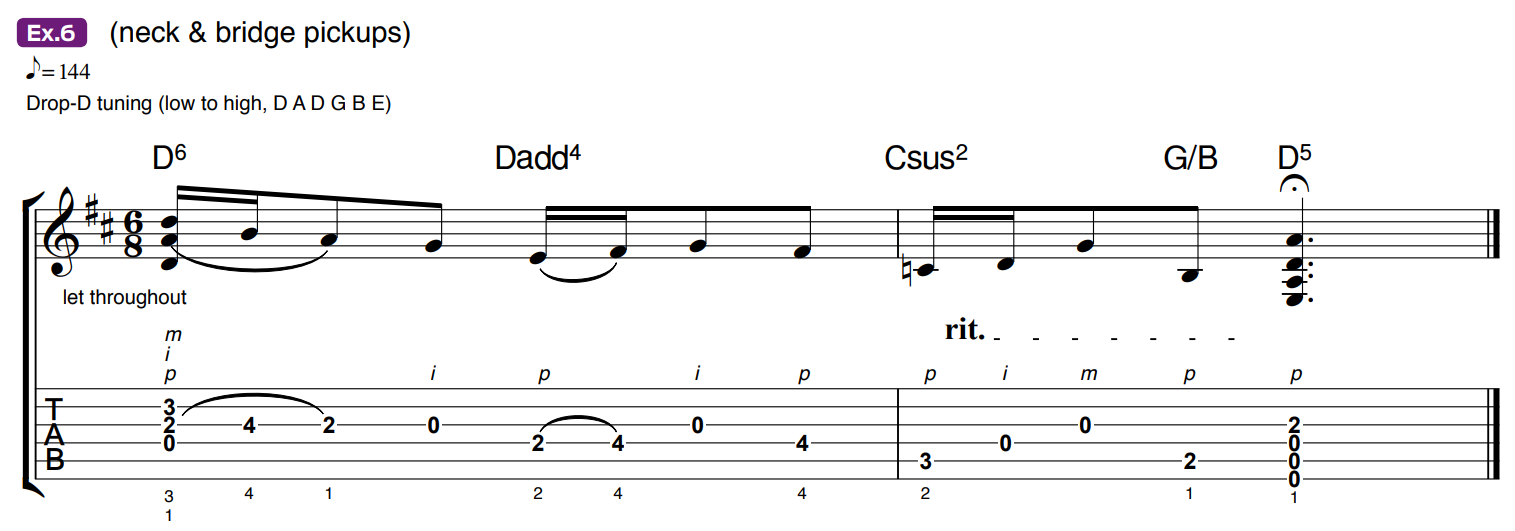
The Mixolydian mode has long been a popular resource for melody makers, soloists and riff writers alike.
Like its close cousin the major scale, Mixolydian (theoretically spelled 1 2 3 4 5 6 b7) has a happy, uplifting quality, but its minor, or “flatted,” seventh degree – as opposed to the major scale’s major, or “natural,” seventh – throws a little funk into the mix, giving Mixolydian its signature dominant-seven flavor.
Let’s explore the mode’s riff-crafting potential with a diverse batch of examples inspired by the playing of some famous pickers.
CHET AND THE BEATLES
We’ll kick off this lesson with a D Mixolydian (D E F# G A B C) example in the style of “Mr. Guitar” himself, Chet Atkins.
Coming to prominence in the 1950s, the mild-mannered Gretsch-wielder inspired legions of budding axe players and future rock and roll stars.

Ex. 1 employs the “Travis picking” technique (named after pioneering country picker Merle Travis), in which the thumb plucks an alternating bass line on the low strings, while the fingers produce counterpoint rhythms on the higher strings.
The “hidden” simplicity lies in the fact that a basic D7 (D F# A C) chord shape, or “grip,” provides the foundation for the entire passage.
All the latest guitar news, interviews, lessons, reviews, deals and more, direct to your inbox!
The Beatles’ vast recorded catalog provides a treasure trove of Mixolydian guitar riffs, solos and vocal melodies.

Ex. 2 is in the broken-chord arpeggiated style of George Harrison’s “If I Needed Someone.”
Based on a seventh-position voicing of A7 (A C# E G), the melody lines are derived from the A Mixolydian mode (A B C# D E F# G), in which the notes of an A dominant seven chord live.

Also derived from A Mixolydian, Ex. 3 is in the style of Harrison’s opening riff from “I Want to Tell You.” This unique melody is played entirely on the D string.
You can hear echoes of George’s original riff in many subsequent, single-string guitar breaks from the 1960s, a prime example being “Pleasant Valley Sunday” by the Monkees.

Ex. 4 is another Harrison-style riff. Rendering a climactic moment in “Here Comes the Sun,” it’s founded on a partial seventh-position E7 chord (E G# B D) and fueled by a rhythmic motif that casts selected notes from E Mixolydian (E F# G# A B C# D) in three-note groupings.
Although George was the official lead guitarist of the Fab Four, John Lennon contributed his fair share of guitar riffs and leads.

The C Mixolydian (C D E F G A Bb) passage in Ex. 5 is based on his ebullient riff from “I Feel Fine.”
Use a maxed-out compression pedal to achieve the desired “squashed” tone.

Ex. 6 is a D Mixolydian (D E F# G A B C) chord-melody figure inspired by Lennon’s “Norwegian Wood.”
Drop your low-E string down a whole step to D, and be sure to let all the notes ring together as much as possible.
While the example calls for fingerstyle technique, it’s also playable with a pick.

Ex. 7 is a nod to Sir Paul McCartney, who also played lead guitar on many Beatles songs, such as “Taxman,” “Sgt. Pepper’s Lonely Hearts Club Band” and “Good Morning, Good Morning.”
This example is based on the horn-section intro of McCartney’s “Got to Get You Into My Life.”
Derived from the G Mixolydian mode (G A B C D E F), it’s arranged for fingerstyle performance, but, as in the previous example, it can also be played with a pick.
LATE ’60S
Granted, Louis Shelton may not be a household name, but his famous riff from the Monkees’ “Last Train to Clarksville” cemented his “first call” session status for many years to come.

Ex. 8 offers an expanded variation on this riff. Based on G Mixolydian, it’s propelled by a series of “banjo rolls,” performed with hybrid-picking (pick-and-fingers) technique.

The E Mixolydian octave example in Ex. 9 exhibits the mellow and melodic side of Jimi Hendrix.
Essentially a mash-up of “Burning of the Midnight Lamp” and “Third Stone from the Sun,” the figure glides up and down the neck with an A- and G-string pairing.
Be sure to mute the “snuggled” D string with the underside of your fret-hand index finger.

Ex. 10 evokes Jimmy Page’s post-solo riff in Led Zeppelin’s “Heartbreaker.”
Harmonized from A Mixolydian (A B C# D E F# G), it incorporates a series of sixths dyads voiced on the D and B strings, which are surrounded by the open A, G and high E strings.
FUNKING IT UP WITH PASSING NOTES

Ex. 11 is inspired by the Mixolydian-based riffs crafted by pioneering guitar-driven funk groups such as Average White Band (Alan Gorrie, Hamish Stuart and Onnie McIntyre).
This example is reminiscent of “Cut the Cake,” in which the D Mixolydian mode is embellished with a “passing” minor third (F) via deftly placed finger slides and hammer-ons.
The funk factor is largely courtesy of the muted string attacks. Herein lies the difficulty. Try to use all of your available fingers to mute the surrounding, unfretted strings in order to prevent any unwanted notes from sounding.

Ex. 12 is a funky, blues-rock riff inspired by Joe Walsh’s “Funk #49.”
This one is based on A Mixolydian with the minor-third, C, add, as a bluesy color tone. Here, an Am7 shape gives way to an A7 (via a G-string hammer-on), then a triad trade-off (D major and G major), and back to the Am7–A7 handoff.
Ex. 13 goes a step further by inserting two passing tones. Inspired by Joe Perry’s quintessential main riff on Aerosmith’s “Walk This Way,” it’s drawn from E Mixolydian (E F# G# A B C# D) with a flatted fifth (Bb) and minor third (G) added.
CLASSIC ’70 AND ’80S

Ex. 14 includes elements used in many classic rock riffs from the ’70s.
Inspired by both Free’s “All Right Now” and AC/ DC’s “Highway to Hell,” this example relies on the A Mixolydian mode’s I, IV and bVII triads, A, D and G.
Ex. 15 is an E Mixolydian mash-up that recasts some of Eddie Van Halen’s hallmark riff maneuvers in songs such as “Panama.”
Inverted triads (the Esus shape substitutes for an A major triad) launch the riff, and natural harmonics on the A and D strings provide the melodic section.

Ex. 16 is inspired by the standout bridge riff in the Steely Dan classic “Reelin’ in the Years,” which featured Jeff “Skunk” Baxter, Denny Dias and guest soloist Elliott Randall on guitars, with the latter delivering one of the most stunning Mixolydian-based solos in the entire classic-rock catalog.
Like the original figure, our example is an exuberant, legato-fueled passage that’s based on the A Mixolydian mode and exploits the open B and G strings, consequently providing a “country hoedown” flair.

The double-stop-fueled, C Mixolydian offering in Ex. 17 represents those southern-rock-style phrases typical of Lynyrd Skynyrd which featured the great guitarists Ed King, Gary Rossington, Allen Collins and Steve Gaines.
Played with a shuffled, swing-16ths rhythmic feel, the passage exudes a “funky-country” attitude.

Ex. 18 is a prog-rock-style example inspired by Rush guitarist Alex Lifeson’s playing in “Limelight.”
Drawn from E Mixolydian, the five-note lead-up to the first D triad (D F# A) injects the riff with an “odd-meter” feel, even though it’s in straight 4/4 time.
INTO THE ’90S
The ’90s grunge era produced a healthy output of melodic guitar riffs.
Chief among the Mixolydian variety is Stone Temple Pilots guitarist Dean DeLeo’s churning riff in “Interstate Love Song.”

Notice how every note of E Mixolydian is accounted for in this embellished rendition (Ex. 19) of the famous riff.

Our final example, Ex. 20, is a nod to virtuoso players such as Joe Satriani, Steve Vai and Eric Johnson, who helped usher in the modern era of high-tech rock lead guitar.
Not for the feint of heart, it’s a revved-up, A Mixolydian legato fest that zips up the fretboard with hammer-ons, slides and strategically placed open-string embellishments.
Crank up the volume and let ’er rip!
